Excerpts from Jim Conrad's
Naturalist Newsletter
from the February 21, 2010 Newsletter issued from Hacienda Chichen Resort beside Chichén Itzá Ruins, central Yucatán, MÉXICO; limestone bedrock, elevation ~39m (~128ft), ~N20.676°, ~W88.569°
PASSION FRUIT
For months I've been eating passion fruits off the vines of a nearby stone wall densely overgrown with passionflower vines -- genus Passiflora of the Passion-Flower Family. You can see one of the fruits hanging next to a typical three-lobed leaf below:
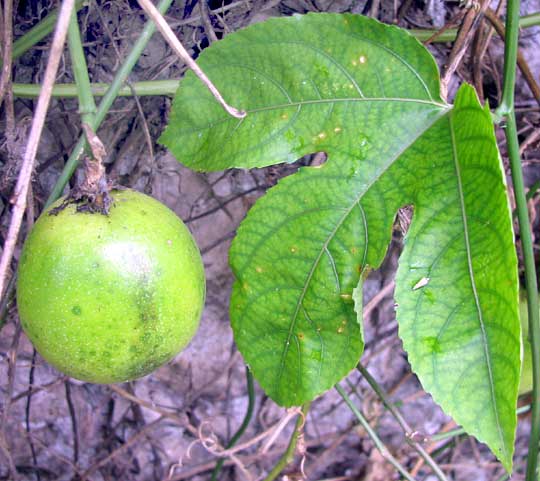
Though many species of Passionflower exist and many cultivars are grown for their edible fruits, I'm guessing that our vines are PASSIFLORA EDULIS var. FLAVICARPA. Passiflora edulis has a purple-fruited variety and a yellow-fruited one, and the picture shows the latter, with the fruit just beginning to ripen.
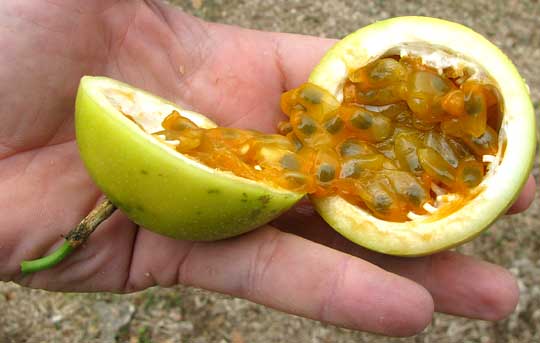
Above the fruit has been cut open to reveal its many semi-hard seeds embedded in their pulpy arils. The aril in passion fruits is the outer covering of the seed, and it arises from the seed's hilum or funiculus. The funiculus is the "umbilical cord" connecting the fruit wall with the seed. You can see macaroni-like funiculi in the picture appearing as stalks arising from the fruit's inside wall. A seed's hilum is the scar or mark indicating the point of attachment of the seed with its funiculus. In the US we often run into fruiting Hearts-a-bustin', genus Euonymus, in which the seeds are enclosed in orange-colored aril that attract birds to come eat the seeds and transport them to parts unknown.
Another distinguishing feature of passion fruits is the tough stem affixed at the fruit's base. That stem is what becomes of the stalk upon which a passion flower's ovary perches inside the flower. You can clearly see the ovary's stalk (known as the gynophore) in the second and third pictures on our Passion-Flower page at www.backyardnature.net/fl_passn.htm.
Passion fruits are good to eat, though our yellow variety is a bit tart to eat without adding lots of sweetening. A delicious drink is made by blending the fruit pulp with ice, water, sugar, and a pinch of bicarbonate of soda. The juice is an excellent source of Vitamin C.
from the October 26, 2018 Newsletter issued from Rancho Regensis north of Valladolid, Yucatán, MÉXICO;
elevation ~40m (~130 ft), N~20.876°, W~88.170°
PASSION FRUITS RIPENING
The rancho's Maya worker Juan brought me a handful of passion fruits he'd just taken from our vine, calling them by their local name, maracuya. When I cut the fruits open, they were all empty, just the fruit's covering with some white pulp. He'd harvested the fruits way too early. However, before throwing the empty shells into the compost, I looked closely at the inside-facing surface of the pulp, and saw that the surface was covered with very tiny, cream-colored, grainy things, as shown below:
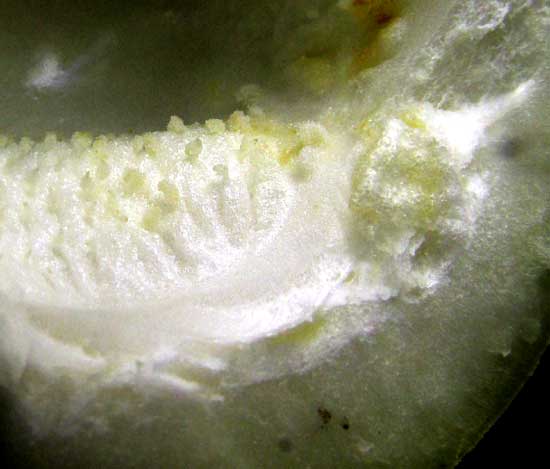
The cream-colored grains are ovules, ovules being a fruit's future seeds. Ovules occur in ovaries, which mature into fruits, so it's unusual to see ovules in an immature fruit this far advanced. I don't know whether the ovules have been aborted, maybe because of the lack of a proper pollinator, or whether this is normal. We don't have enough fruits for me to settle the matter.
Still, it's interesting that the ovules are clearly attached to the fruit's pulpy wall by white, columnar "funiculi," which are the plant equivalent of animal's umbilical cords. When ovules are borne on the side walls of an ovary, the placentation is described as "parietal," and parietal placentation is a little unusual in the world of flowering plants. When you're identifying a plant and see that its ovary or fruits display parietal placentation, you can narrow down your options very considerably.
The Passion-Flower Family, the Passifloraceae, is one of those few families with parietal placentation, along with the Papaya, Flacourtia, Violet Families, and a few others. You might be interested in seeing the different placentation types in our altered copy of a drawing from my old Baileys Manual of Cultivated Plants at www.backyardnature.net/n/18/180928bi.jpg
from the May 9, 2010 Newsletter issued from Hacienda Chichen Resort beside Chichén Itzá Ruins, central Yucatán, MÉXICO; limestone bedrock, elevation ~39m (~128ft), ~N20.676°, ~W88.569°
YELLOW PASSION-FRUIT FLOWERING
In last February's Newsletter we met our fruiting Yellow Passion Fruit vines, shown above. Now those same vines are flowering, gorgeously so. You can see a three-inch-across (7.5 cm) blossom below.
(By the way, passionflower blossoms display some unusual anatomy. You might enjoy figuring out what the various parts are of the blossom in the above picture by referring to my Passionflower page, with parts labeled, at www.backyardnature.net/fl_passn.htm.)
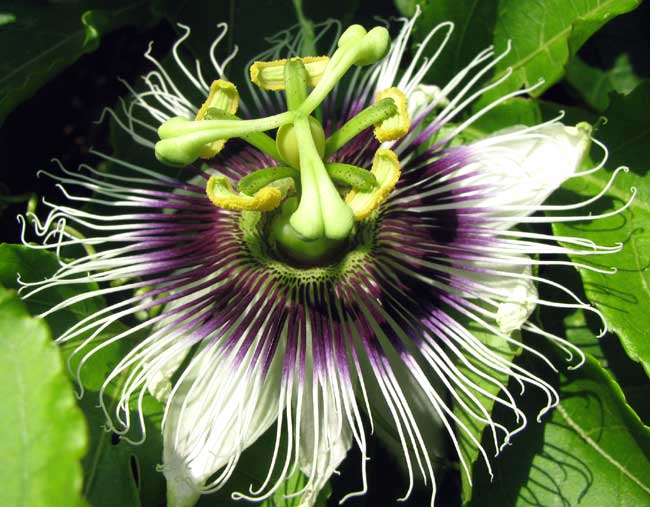
from the May 7, 2017 Newsletter issued from Rancho Regensis north of Valladolid, Yucatán, MÉXICO;
elevation ~40m (~130 ft), N~20.876°, W~88.170°
NECTAR ROBBERY OF PASSION FLOWERS
Nowadays a passionflower vine here at the ranch is loaded with blossoms, a close-up of the complex and beautiful center of one flower being shown below:
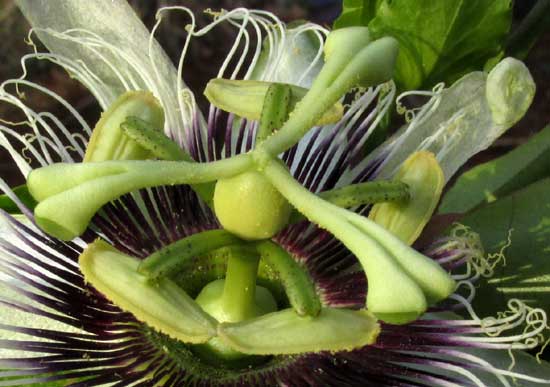
Many of our vine's flowers are damaged. Below, you can see one not yet expanded, but with one side completely ripped away, one of the pistil's three stigma arms broken off, several stamens missing and others mangled, and an entire sepal gone:
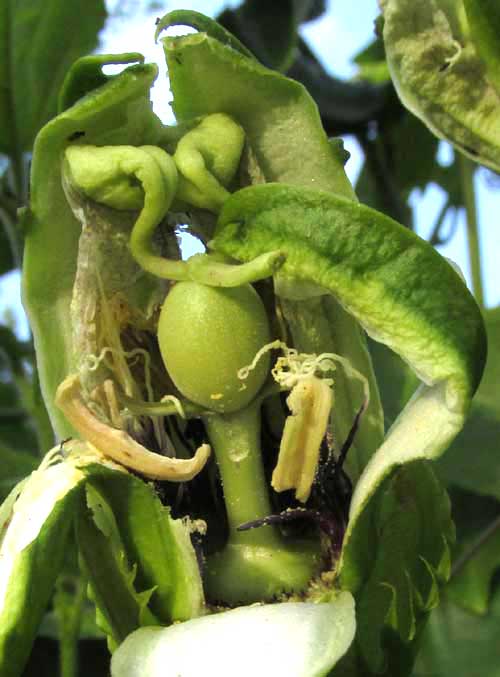
This damage was caused by an animal robbing the flower's nectar, so who was the robber? My guess is that it was a bat, a rodent, or a bird and, if a bird, maybe an Altamira Oriole or Golden-fronted Woodpecker, both frequently seen here ravaging fruits such as oranges and bananas.